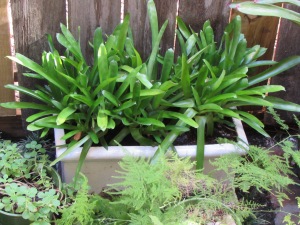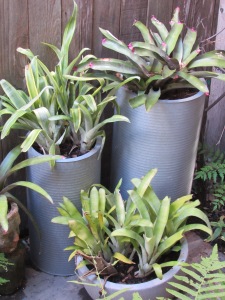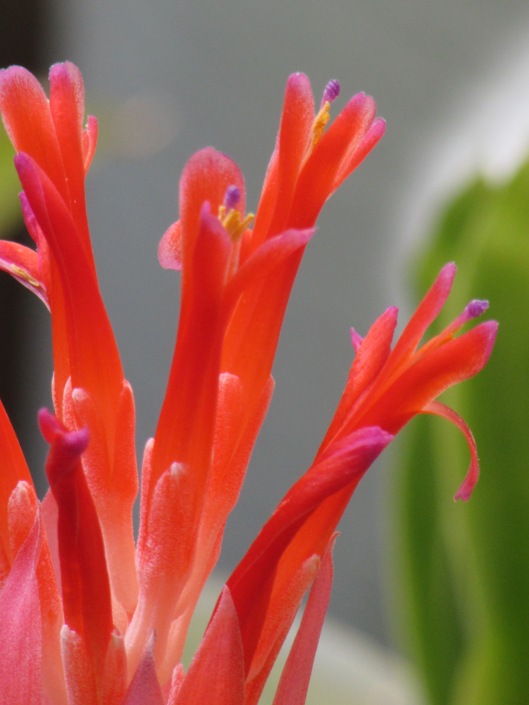Tags
Aechmea, bromeliad, Matchstick Plant Aechmea gamosepala, Painted Fingernail Bromeliad Neoregelia spectabilis
A while back I was doing a design for a fellow that has a beautiful old brick bungalow in Montrose. He wanted us to design a back garden that was super low-maintenance and had a bit of the Texas hill country feel. He travels to, and weekends at, his other property in the hill country. He also wanted us to find new plants to include in his collection of cement urns and other pottery on his screened-in front porch. I spent some time thinking what would work. I like to grow plants on my own porch that will not grow in the ground here in Houston. Many of them have to come inside when we have a hard freeze. I knew those were out for the client because this is just his city place and not were he rests his boots.
I decided a nice collection of bromeliads would be perfect. I have a Silver urn Aechmea fasciata bromeliad that I bought at the grocery store 15 years ago that has at times been seriously neglected and still keeps on going. Now to find a good source. I remembered a friend I had met recently, and had the best time talking about plants, might be a source. Dobson is a bit of a plant finder and I wrote him to see if he had any bromeliads he might like to sell. He wrote back and said all his bromeliads needed to be divided and if I had pots and soil he would share them with me. He wouldn’t take any money so I gave him a big Queen Emma crinum lily and some other fun plants we had in our holding area as a trade.
As it turned out the job got postponed to spring and so I decided instead of sitting on these plants in plastic pots all winter I would add some to my collection and share some. I set aside two Painted Fingernail bromeliads he gave us and shared them with friends in Austin. I gave some to one of our crew that also loves bromeliads. The two here in the red pots are from Dobson. He told us great stories of going to Mexico over 30 years ago and camping in the mountains and on the beach. He loved bringing back plants. Seems he learned the hard way that you have to shake out the bromeliads before storing them in your car because scorpions like to hide in them.
He told us that bromeliads prefer rainwater and that keeping the soil wet isn’t as important as water them in the leaf tank. He said they once they bloom they send out pups and then they die. I have one that bloomed years ago and is still going strong but I now know it will not bloom again. The blooms on many of the bromeliad are very exotic and worth waiting for. Almost all bromeliads are native to places with a tropical climates. This means they want a habitat that is warm and humid. They usually grow on shady forest floors or attached to trees. Houston, being a temperate sub tropical zone 9, is perfect. Except recently we have had some hard freezes. Most of my bromeliads are fine down to about 25 degrees and spend most of the winter on my porch. I may have to cover these new ones in the corner if we have another cold winter.
Most of the bromeliads I have are Aechmea (pronounced EEK-me-uh) This genus is very adaptable and can be grown indoors or out. Aechmea gets its name from a Greek word meaning “spear tip”. Most Aechmeas are epiphytic meaning they grow non-parasitically on another host like a tree. They are fine in pots, just remember their root systems are not large and are primarily for anchoring. In their native habitat they take in water from rainfall and nutrients from dust, insects, and other particles that have collected in their tanks.

Aechmea, Bromeliad, Matchstick Plant
Aechmea gamosepala
Aechmea’s foliage grows without a stem. The leaves grow together forming a rosette shape. This allows them to collect water in the rosette, which is also referred to as a tank. The water stored in the tank helps it to survive through periods of sporadic rainfall. Using rain water will help prevent the build up of salts commonly found in tap water. Aechmeas can become top heavy. Their foliage is large and meaty yet their root systems is small. Just last week one of the bromeliads Dobson brought us bloomed. Since most bromeliads only bloom once in a lifetime it is so exciting to see this one unfold with its brilliant colors!
What look like bright colored flowers are actually leaves called bracts, and from them an inflorescence may grow. Bromeliads grow by added new leaves to the center of the plant. Eventually they will become too crowded and will no longer have room to form new leaves, this is when they put their energy into producing offsets also called pups.
For more information on growing bromeliads check out Bromeliads info, plant care.
Happy Gardening!








Wow! I really love these. I always asumed they would be hard to grow — especially wit the extreme summer temperatures but yours look great! Your friend said they prefer rainwater and I believe it. Austin’s water is really hard and they add chloramine as a disinfectant. I remember back in the day I could let water sit for a day and the chlorine would dissipate within 24 hours but the chloramine they these days instead is much more stable and tough on plants.
LikeLike
These have been in the corner all summer with mid day sun and they are happy as can be. I don’t have many house plants because the A/C really dries them out. We have the chloramine now too and I really noticed how the plants didn’t like it during our drought. We have been having regular rain this year and everything has really perked up. I save rain water for my porch plants from one of my down spouts. I just haven’t found a place to install rain-barrels (yet).
LikeLike
Very informative post and beautiful photos! I wish we could enjoy plants like this in the Midwest!.
LikeLike
Thank you! They do fine inside too if you make sure to mist them every few days.
LikeLiked by 1 person
Beautiful Bromeliads! I like your collection of pots, the silver cylinders look great with the plants. The inflorescences are such a pretty color and form, and I like the little magenta accents of the pistils. I admire people with the skill to grow plants like that.
LikeLike
Thank you Hannah…these plants pretty much take care of themselves. If it hasn’t rained then I water them once a week or less in cold weather. I did have fun collecting the containers. The galvanized cylinders are from CB2, Crate and Barrels new online site.
LikeLike
Cool plants with a cool story. I love when there’s more to a new plant than “I got it from Walmart” 🙂
I’m glad you didn’t leave them in black plastic, they really make a nice accent now… another plant group I should stay away from since they would need about 5 months indoors here!
LikeLike
Thank you Bittster : ) now worries about Walmart, I don’t shop there and I even avoid plants from other big box stores. We have so many local nurseries near me and then I order from growers for our clients that I am sport for choice! Wow 5 months is a long winter. Even here we had a very cold winter last year with one night going to 18 degrees which is not normal. We have many winters that it never gets below 30. The bromeliads I have made it through last winter outside so I think they will be fine in there sheltered corner. We will see!
LikeLike
I think for humid places, it’s nice to see bromeliads used so well…they do for there what all the spiky stuff does out here that can take dry heat / shade, but I failed to water enough. Your Matchstick Plant is nice…
LikeLike
DD perhaps that is why I like them. I am missing the cacti and succulents of So Cal. These all have been through some hard freezes in there previous home so I will see how they fair for me. I like to explore outside the box. And if I never see another wax leaf ligustrum….
LikeLike